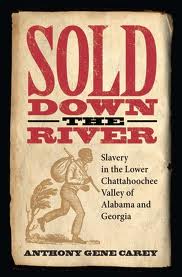 Sold Down the River: Slavery in the Lower Chattahoochee Valley of Alabama and Georgia by Anthony Gene Carey. Tuscaloosa: University of Alabama Press, 2011. Cloth, ISBN: 0817317414. $29.95.
Sold Down the River: Slavery in the Lower Chattahoochee Valley of Alabama and Georgia by Anthony Gene Carey. Tuscaloosa: University of Alabama Press, 2011. Cloth, ISBN: 0817317414. $29.95.
Some may lament that works of history are increasingly written with specialized readerships in mind, readerships that welcome long introductions laden in historiography and theory. Sold Down the River: Slavery in the Lower Chattahoochee Valley of Alabama and Georgia is a (perhaps) welcome break from this trend. In particular, this book is an highly accessible, cogently written, entertaining, multi-thematic, yet impressively-researched, community study of the institution of slavery—and its Creek, African American and Caucasian participants—in the antebellum lower Chattahoochee River Valley. Anthony Gene Carey, vice provost for faculty affairs and a professor of history at Appalachian State University, readily acknowledges that he wrote this study with the non-specialist, the local historian and the undergraduate in mind. In his words, the book has “more of an empirical than a postmodern bent” (6). As such, it is not surprising that the book lacks an overarching thesis. Despite this reality, Sold Down the River holds much value for professional historians. Specifically, the Chattahoochee River Valley—although located geographically in the heart of Dixie—was among the last settled places of the South…and is one of the most understudied. Scholars will thus find Carey’s contribution a useful counterpoint to works that focus on slavery in other regions within the antebellum South. Court records, Creek colonial government documents, newspapers, agricultural journals and farming periodicals, letters and diaries, travel accounts, church records, and Works Progress Administration (WPA) slave narratives are among the primary sources Carey used to support his arguments. In praise, this study was written overwhelmingly from primary sources; the author carefully avoids drawing conclusions about the Chattahoochee River Valley based on the findings of other scholars for other slaveholding areas.
Sold Down the River begins with a largely chronological chapter on the long Creek involvement with slavery. In contrast, the remainder of the book is topically arranged. Carey organizes these chapters around a central argument, in so doing highlighting such themes as the primacy of the interstate slave trade during those years of explosive growth in the Chattahoochee River Valley; the objectification of slaves and the solidification of slavery as a race-based institution; the ways by which profits and paternalism shaped master-slave relationships; slaveholder power versus slave resistance; slaves’ participation in their own marketplace; and the role that evangelical Christianity played for both black and white communities.Although slaveholders are an important component of Carey’s book, Sold Down the River is primarily an account of the slave experience in the lower Chattahoochee River Valley. Falling in line with much of the literature on the slave experience,Carey adopts a characterization of slaves as both victims and resistors who sought to shape their own African American culture that was a product of syncretism.
What separates this book from the hundreds of others written about the institution of slavery is Carey’s emphasis on the human element. When at all applicable, Carey incorporates powerful, moving quotes from both black and white sources, and, as a result, readers can begin to conceptualize the slave’s and slaveholder’s motives, ideas, morals and emotions. Furthermore, and perhaps of particular interest to the lay reader, Sold Down the River provides considerable detail about the day-to-day lives of the Chattahoochee River Valley’s black and white residents. For example, readers can clearly visualize the extent to which slave housing arrangements forced physical intimacy; the often agonizingly violent and psychologically-damaging nature of slave discipline and slaveholders’ discomfort of viewing their chattel simultaneously as spiritual equals and secular subordinates.
Carey concludes his study with a largely unsatisfying, excessively generalized discussion of the black and white experience during the Civil War and postbellum eras. Although Carey suggests to readers that they consult Susan Eva O’Donovan’s Becoming Free in the Cotton South for a more nuanced analysis of these years, Carey’s book would have been stronger had he simply ended with southern secession. Also disappointing are Carey’s sources and analysis, which focus considerably more heavily on slavery in Alabama than they do on the Georgia side of the Chattahoochee. Nonetheless, while Sold Down the River offers little original insight into the institution of slavery, it does add to our collective understanding of slavery by highlighting a region of the South that to date has received little attention.
Katherine E. Rohrer University of Georgia
Katherine is a Ph.D candidate in the Department of History at the University of Georgia. She is currently completing research for her dissertation which will trace the rise of the urban South between 1830 and 1900.
